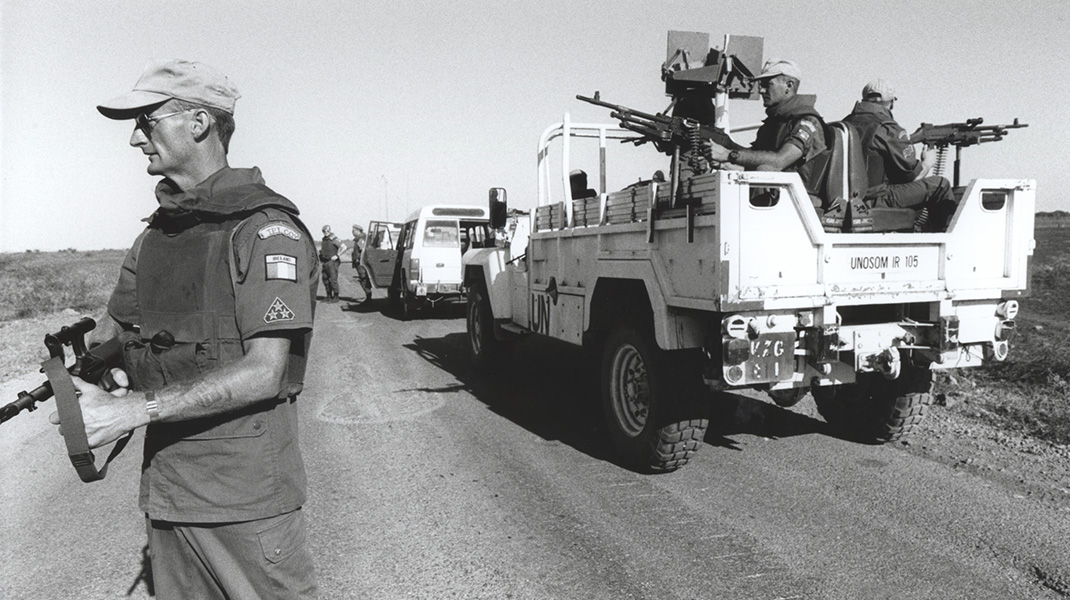United Nations Operation in Congo
ONUC – July 1960 — June 1964
July 27th 1960 marked a watershed when the first element of 32 Inf Bn, the first complete unit from the Defence Forces to serve overseas, took off from Dublin bound for the Congo. After gaining independence from Belgium the previous month the Congo descended into something approaching anarchy.
With Belgian nationals being subjected to random attacks the Belgian government sent troops to their former colony and refused to remove them until the safety of their nationals could be guaranteed. Prime Minister Patrice Lamumba emerged as de facto leader but failed to unite the country. The army mutinied and Katanga province took the opportunity to declare its independence. This led to civil war in Katanga, between the secessionists, led by Moise Tshombe, and the supporters of Lamumba, mainly Baluba tribesmen.
Lamumba successfully appealed to the UN for intervention and on July 13th Ireland was one of the countries requested to provide troops to the proposed ONUC mission. The Irish government passed the enabling legislation on July 19th and a new battalion designated 32 Inf Bn (31 Inf Bn had existed in the Defence Forces until 1946) was activated for deployment.
Eight days later the first chalk, comprising the battalion commander, Lt Col M J Buckley, and 60 members of the unit, flew out of Dublin, to be followed shortly after by the remainder of the 635-strong battalion.
Initially deployed in Kivu province the Irish unit was joined by 33 Inf Bn in August, bringing the Irish contingent to over 1,000 troops. Their main tasks were restoring essential services, reassuring the public, and overseeing the resumption of local trade. In November the Irish contingent were redeployed to Katanga, a much more dangerous area of operations where vicious inter-tribal warfare was taking place between the Balubas, the Conekats, and the Pygmies. War parties were rampaging through the countryside, burning villages and attacking trains.
Shortly after moving into the area the tragic Niemba ambush took place on November 9th when nine of an 11-man Irish patrol were killed by Baluba tribesmen.
In early 1961, during the tour of duty of 35 Inf Bn and 1 Inf Gp, Katanga erupted in violence and the Irish Contingent sustained casualties in battles with the Katanga Gendarmerie.
On Friday the 15th of September 1961 Trooper Patrick Mullins., who was a member of the 35th Infantry Battalion, died as a result of hostile action in Elizabethville in the Republic of Congo. In 2011 the Defence Forces commorated the 50th Anniversary of his death.
In December 36 Inf Bn arrived in the country and within two weeks they were involved in the Battle of the Tunnel, in Elizabethville, during which three members of the unit were killed. The exploits of the Irish troops in taking the Tunnel were recognised by the 14 Distinguished Service medals awarded to ‘A’ Coy personnel.
The next few years saw the decline of the secessionists and eventually Tshombe went into exile in 1963. By 1964 the Congolese government felt secure enough to let Tshombe return to the country as part of an overall agreement. Although the country was still politically and economically unstable it was felt that the danger from a military viewpoint had passed and the UN’s military mission was wound up. In June of that year 2 Inf Gp flew home to Ireland, ending the Defence Forces’ four-year commitment.
During the ONUC mission the Defence Forces came of age and took its place on the international stage. It had been a difficult and traumatic mission (one MMG and 65 DSMs were awarded over the four years) in which the Irish troops’ performance and even-handedness in dealing with all parties had earned them a new respect within the UN. Even before the last troops had left the Congo Ireland had been requested to supply a contingent to a new UN mission in Cyprus. Little did anyone imagine at the time that the Congo had been the beginning of over 50 years of unbroken service on UN missions for the Irish Defence Forces.
| Operation Details |
| Ribbon for the Medal |
 |
| Duration |
28 July 1960 — 30 June 1964 |
| Operation Type |
UN led Peacekeeping Operations (Troop deployment) |
| Commitment |
6191 cumulative missions |
United Nations Transition Assistance Group
UNTAG – March 1989 — April 1990
The United Nations Transition Assistance Group (UNTAG) arose from the dispute between the occupying South African authorities, and the South West Africa People’s Organisation (SWAPO), which strove for the independence of Namibia. SWAPO and its military wing, the People’s Liberations Army of Namibia (PLAN), were supported by neighbouring Angola, which allowed PLAN fighters and their Cuban allies to operate from its territory.
In 1978 the UN Security Council passed Resolution 435, establishing UNTAG for a period of 12 months, to ensure Namibian independence through free elections under the UN’s supervision and control. This was not implemented at the time, as South Africa introduced a link between their withdrawal and the withdrawal of Cuban forces from Angola.
It was November 1988 before all parties (Cuba, Angola, South Africa and the United States) agreed to a phased Cuban withdrawal. UNTAG commenced in 1989.
Because of PLAN’s large presence in southern Angola, UNTAG-ANGOLA (UNTAG-A) was formed to monitor the confinement of PLAN fighters to their Angolan bases. UNTAG-A’s mandate was fulfilled after only 330 days. UNTAG’s duties in Namibia ended a month after independence was secured.
| Operation Details |
| Ribbon for the Medal |
 |
| Duration |
16 March 1989 — 7 April 1990 |
| Operation type: |
UN led Peacekeeping Operations (Observer) |
| Commitment: |
20 |
Second United Nations Angola Verification Mission
UNAVEM II – July 1991 — September 1993
On May 1st 1991 the Angolan Government and UNITA rebels signed the ‘Peace Accords for Angola’, aimed at ending the lengthy civil war. An important aspect of the accords was the suspension of hostilities from May 15th.
Resolution 696 was adopted by the UN Security Council at the end of May establishing UNAVEM II.
A number of joint commissions were established by the Angolan Government and UNITA to verify the implementation of the Peace Accords. Observers from UNAVEM II attended all meetings of these commissions. Their main function, however, was to observe the workings of joint Government/UNITA monitoring groups. These groups, consisting of equal numbers of monitors from both sides, were established in 50 locations where troops of the conflicting parties were to be assembled during the cease-fire.
UN Observers were also stationed at 12 other ‘critical points’ in the country and were tasked with regular patrolling of a number of other locations. The unarmed UNAVEM II personnel also assisted in the investigation and resolution of alleged violations of the ceasefire.
Irish participation with UNAVEM II came to an end in September 1993.
| Operation Details |
| Ribbon for the Medal |
 |
| Duration |
3rd July 1991 — 9th September 1993 |
| Operation Type |
UN led Peacekeeping Operations (Observer) |
| Commitment |
18 Cumulative Missions |
Second United Nations Operations in Somalia
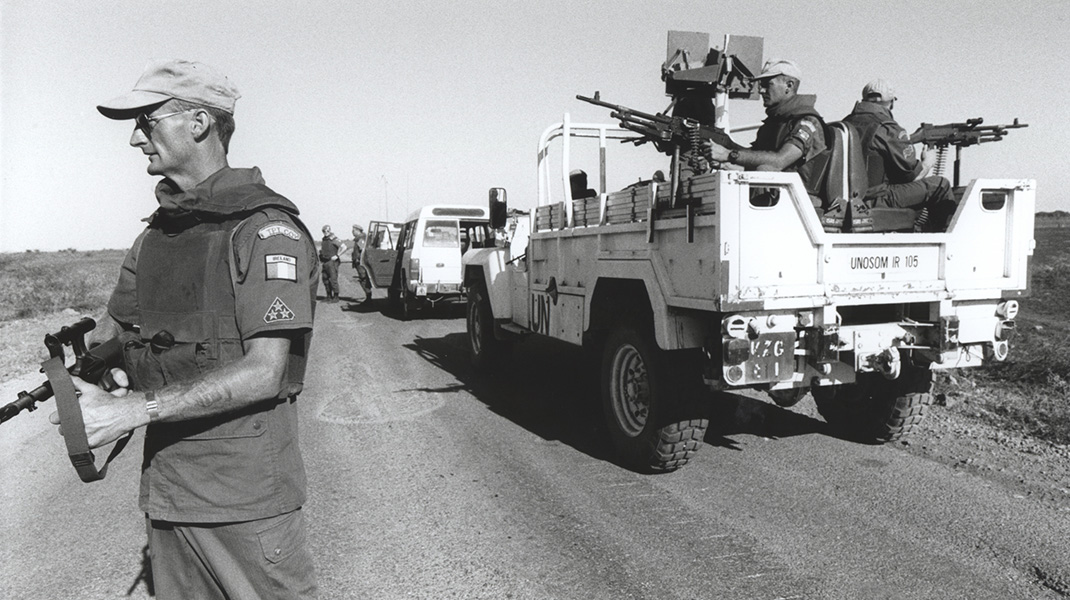
UNOSOM II – August 1993 — January 1995
In 1990 a loose association of Somali clans ousted President Siad Barre from power in the strategically placed East African country, which dominates the entrance to the Red Sea. Two of the clan leaders, Ali Mahdi and General Farah Aideed, took the main positions but soon fell out. Vicious inter-clan fighting led to the deaths of 30,000 Somalis in 1991/1992, in addition to the estimated 200,000 who died as a result of famine.
International aid agencies trying to alleviate the effects of the famine were unable to operate effectively due to the looting of ships and aid convoys, and the murder of aid workers in the country, which had descended into anarchy.
In January 1992 UNSCR 733 led to the establishment of UNOSOM. However the strength of the initial force was inadequate. After visits to Somalia by Foreign Minister David Andrews and President Mary Robinson, Ireland agreed to contribute a transport company.
However, a deteriorating situation in the country led to the UN Security Council invoking Chapter VII of the UN Charter in November 1992. UNSCR 794 effectively changed the mission to one of peace enforcement. This caused 1 Tpt Coy’s deployment to be delayed as new legislation was required in the Dáil for Irish troops to participate in peace enforcement missions. Also UNOSOM had been sidelined by the US-led UNITAF task force. With a strength of 37,000 UNITAF quickly stabilised the situation and handed over to UNOSOM II in May 1993. The new mission had a revised mandate, which included the requirement to disarm the Somali factions. On June 5th, 24 Pakistani UNOSOM troops were killed in fighting with Aideed’s clan, and in October 18 US Rangers, operating independently of UNOSOM, were also killed, leading to the US declaring its intention to pull all its troops out by the end of March 1994.
It was into this cauldron that 1 Tpt Coy eventually flew in September 1993. Equipped with 40-plus vehicles, the Irish contingent was based in Camp Shannon in Baidoa, 177 miles from Mogadishu. The Irish contingent’s main task was ferrying supplies for the brigade based in the Baidoa region. Initially this was a French brigade but they were replaced towards the end of 1993 by an Indian brigade.
The weekly ‘Mog run’ to Mogadishu, where all supplies arrived, was a dangerous affair. Even in the wake of an October 1993 ceasefire attacks aimed at capturing vehicles, arms or food were still a regular feature of life in Somalia. One such attack on the ‘Mog run’ during 2 Tpt Coy’s tour of duty led to a fire fight between the convoy’s Indian escort and a large group of bandits, resulting in the deaths of at least 11 of the attackers.
In September 1994, the Irish contingent withdrew from the mission, although Lt Col Dorcha Lee, UNOSOM’s Senior SO Co-ordination, remained in his position until the mission came to a complete end in February 1995.
| Operation Details |
| Ribbon for the Medal |
 |
| Duration |
August 1993 — January 1995 |
| Operation type: |
UN led Peacekeeping Operations (Troops) |
| Commitment: |
177 cumulative missions |
United Nations Mission in Ethiopia and Eritrea
UNMEE – November 2001 to June 2003
In 1998 a border dispute erupted in conflict between Ethiopia and Eritrea. An agreement brokered by the Organisation of African Unity (OAU) in 1999 fell apart and fighting resumed in May 2000. Another agreement reached in July 2000 committed both countries to the cessation of hostilities and pledged both to call on the United Nations, in co-operation with the OAU, to establish a peacekeeping operation.
UNSCR 1312 outlined the UNMEE (United Nations Mission in Ethiopia and Eritrea) mission with 100 military observers. Following a report by the UN Secretary General in August a new Resolution was passed which expanded the mission to 4,200 military personnel, including 200 observers.
The Defence Forces contributed a 200-strong Guard & Administration Component to the mission from November 2000 until June 2003.
The unit was responsible for providing security for UNMEE Force HQ, the Staff Officers’ Camp, and the Irish base, Camp de h-Íde, as well as carrying out convoys and recce patrols.
| Operational Details |
| Ribbon for the Medal |
 |
| Duration |
November 2001 to June 2003 |
| Operation type |
UN led Peacekeeping Operations (Troops) |
| Commitment |
630 cumulative missions |
Operation Artemis
ARTEMIS – June 2003 – September 2003
When renewed fighting broke out in the Congo in May 2003 following the departure of Ugandan troops from Ituri province, a security vacuum was created that the MONUC mission was unable to fill.
As an immediate response United Nations Security Council Resolution 1484 was passed, authorising the establishment of an interim emergency multinational force (IEMF) to stabilise the situation pending the reinforcement of the MONUC mission.
The IEMF was sub-contracted to the EU, becoming the first autonomous EU military mission to operate outside Europe. The mission, codenamed Operation ‘Artemis’, was established in accordance with the EU ‘Framework Nation’ concept, with France taking on the role of lead nation.
Beginning to deploy in June the mission reached its full strength of 1,400 troops by July 6th. Operation ‘Artemis’ was confined to the town of Bunia, the capital of Ituri province and succeeded in stabilising the area. The mission completed its mandate on time and handed over to MONUC’s Ituri Brigade on September 1st.
The Defence Forces provided two staff officers at HQ level to Operation ‘Artemis’
| Operation Details |
| Ribbon for the Medal |
 |
| Duration |
June 2003 – September 2003 |
| Operation Type |
EU led crisis management Operation |
| Commitment |
2 Cumulative missions |
United Nations Mission in Côte d’Ivoire
MINUCI – 2003 – 2004
In May 2003 the MINUCI mission to Côte d’Ivoire was set up by UNSCR 1479 after the UN determined that the situation in the country constituted a threat to international peace and security in the region. The mission, which included a military component, was tasked with assisting in the implementation of an agreement between the conflicting parties and complementing the operations of the peacekeeping force in the country provided by West African states and France.
In April 2004, the UN determined that the situation in Côte d’Ivoire still posed a threat to international peace and in Resolution 1528 the MINUCI mission was replaced by a UN peacekeeping operation, UNOCI. The new force’s new mandate incorporated MINUCI’s but was expanded to include disarmament, demobilisation, reintegration, resettlement and repatriation, as well as protecting UN personnel.
The force has a strength of 6,640 military personnel including 200 military observers. It is among this observer group that officers from the Defence Forces continue to serve.
| Operation Details |
| Ribbon of the Medal |
 |
| Duration |
2003 – 2004 |
| Operation Type |
UN led Peacekeeping Operations (Observer) |
| Commitment |
2 |
United Nations Military in Liberia
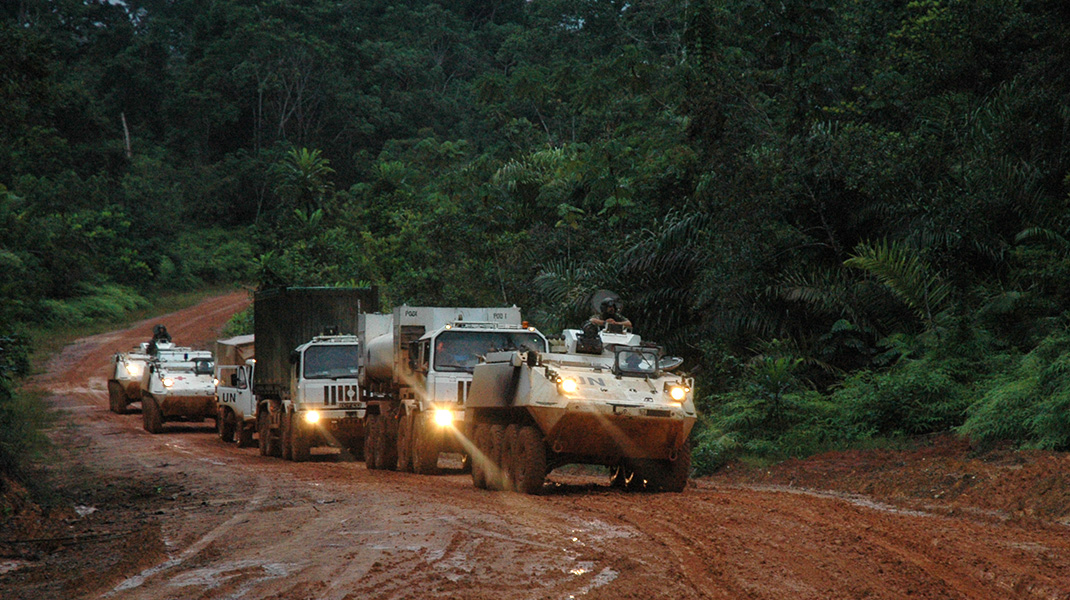
UNMIL – November 2003 – 31 May 2007
Civil war in the West African country of Liberia from 1989 to 1997 claimed the lives of almost 150,000 people, mainly civilians, and led to a complete breakdown of law and order in the country. It also threatened to destabilise neighbouring countries of Sierra Leone, Guinea and Côte d’Ivoire. Despite efforts by the UN and the Economic Community of West African States (ECOWAS) to broker a peace agreement in the country outbreaks of fighting continued sporadically. Following elections in 1997 Charles Taylor of the National Patriotic Party (NPP) was elected president. However, continued human rights abuses, the exclusion and harassment of political opponents, the failure to reform the security services, and ongoing differences between opposing groups contributed to a resumption of conflict in the country.
The main threat to Taylor’s government came from the Liberians United for Reconciliation and Democracy (LURD) based in the north-western Lofa region.
A major offensive by LURD forces began in 2001 and in 2002 a state of emergency was declared as LURD fighters advanced to within 50km of the capital, Monrovia. By early 2003 LURD had broken through to the coast and were within 20km of Monrovia. At the same time the Movement for Democracy and Elections in Liberia (MODEL) launched an offensive in the south of the country. By July 2003 LURD had captured two of Monrovia’s three ports and MODEL had captured the remaining port. In August, in response to the impending humanitarian crisis in Liberia the UN Security Council passed Resolution 1497, authorising the intervention of a multinational peacekeeping force from ECOWAS, pending the establishment of a UN stabilisation force. The intervention force, called ECOMIL, deployed into Liberia and on August 27th a comprehensive peace agreement was signed in Accra, Ghana, by all parties to the Liberian conflict.
The following month UNSCR 1509 was passed establishing UNMIL with a mandate to support the implementation of the ceasefire agreement and the peace process; to protect UN staff; to support humanitarian activities; and to assist in national security reforms, including the formation of a restructured military. On October 1st UNMIL took over peacekeeping duties, incorporating 3,500 ECOMIL troops into the new force.. Irish involvement with the 15,000-strong mission commenced in November 2003. In addition to 90 Inf Bn, consisting of a Logs/Admin Company, APC Company, and Support Company, members of the Army Ranger Wing also deployed to the mission area. The ARW was designated the Special Operations Task Group (SOTG) and came under the direct command of the Force Commander UNMIL. The function of the SOTG was to provide the Force Commander with capabilities for special reconnaissance, human intelligence, liaison, and hostage rescue or extraction.
Much of the ARW’s mission with the SOTG was carried out through long-range patrols, many in excess of nine days’ duration, in the more remote areas of Liberia that were either outside UNMIL control or where there were reports of activity by former combatants. SOTG operations included insertions by land, sea and air, the latter being made by Ukrainian Mi26s, capable of transporting the unit’s specially adapted reconnaissance vehicles.
Although providing humanitarian assistance was not a direct tasking for the SOTG it became a regular feature mainly in the form of medical assistance to the local population by the unit’s MO and patrol medics.
Among many similar operations carried out during their deployment the ARW personnel received a high degree of media attention for their freeing of 37 civilians who were being held by armed elements in a 20ft container in Yekepa. This particular operation led to the arrest of 10 of the armed elements. Meanwhile the 450-strong 90 Inf Bn, mainly drawn from 4 W Bde, took on the task of providing UNMIL’s Quick Reaction Force (QRF). At the heart of the QRF is the APC Coy, equipped with 22 Mowags. These are supported by the Logs/Admin Coy (comprising transport, CIS, Logs/Admin, and Medical platoons, MP and Ordnance sections, and a National Support Element) and Support Coy (comprising an Engineer platoon, an 81mm Mortar platoon, and a Cavalry troop, equipped with AML 20s and AML 90s).
The HQ of the Irish contingent was established in the grounds of an abandoned hotel 10km north of Monrovia and was named Camp Clara.
Shortly after the QRF was established it was augmented by a 230-strong Swedish mechanised company, equipped with CV90 infantry combat vehicles, BV309 AFVs, and Patria APCs. The Irish/Swedish QRF provides the main mobility and firepower resources for UNMIL. They are also the only European contingents operating on the ground with the 15,000-strong mission — Ukraine provides UNMIL’s air lift capability, operating mainly Mi8 helis as troop transporters and Mi24 heli-gunships for force protection, and personnel from several other European countries serve in UNMIL HQ in Star Building in Monrovia. The QRF’s mission mainly consists of long-range ‘recce in force’ patrols and providing rapid reaction to any emergency that may arise in any of UNMIL’s four military sectors.
The long-range patrols, usually of 3-day or 10-day duration, are generally of company size and are carried out both in vehicles and on foot. Patrolling covers the whole of the country but much of it takes place in Monrovia and along the borders with Sierra Leone and CÁ´te d’Ivoire. In remote areas patrols are often inserted by air and sometimes by sea. In order to be able to carry out its rapid reaction task the QRF has a company on standby at all times and ready to go at 30 minutes notice.
When serious rioting erupted in Monrovia in November 2004 the QRF was deployed and played a significant role in quelling the violence. In addition to their military tasks all of the Irish contingents serving with UNMIL have also become heavily involved in humanitarian and CIMIC (civil-military co-operation) projects. Through funding from the departments of Defence and Foreign Affairs and fund-raising efforts by personnel on the ground many projects have been undertaken. These include the construction of a major extension to a HIV/AIDS hospice in Monrovia run by the Sisters of Charity, and support for leprosy and polio centres and numerous schools.
| Operation Details |
| Ribbon of the Medal |
 |
| Duration: |
November 2003 to May 2007 |
| Operation type: |
UN led Peacekeeping Operation (Troops) |
| Commitment: |
2745 cumulative missions |
United Nations Mission in the Central African Republic and Chad, EUFOR Chad/CAR
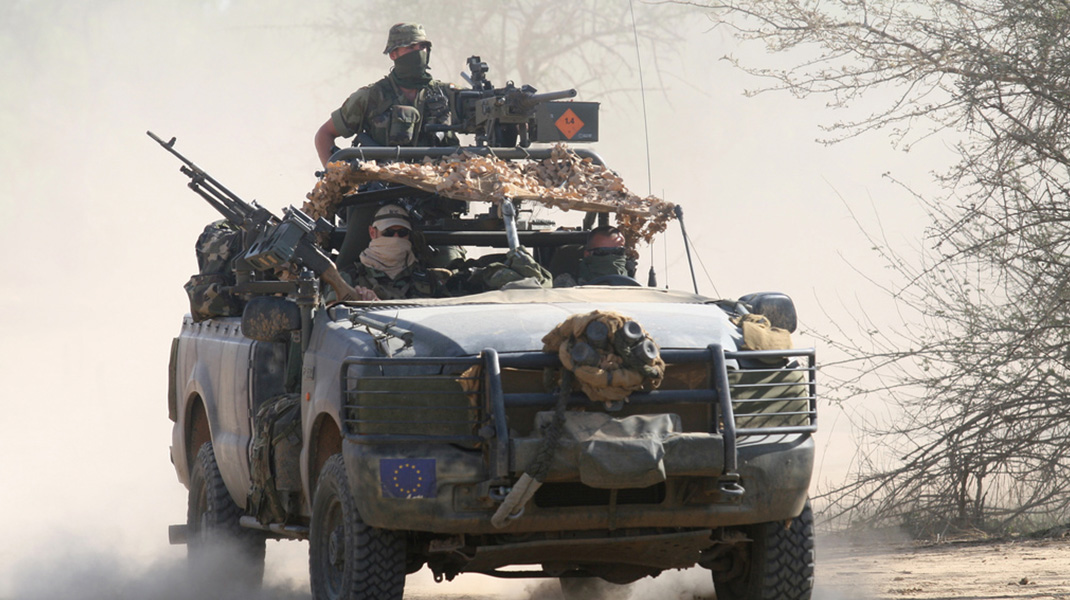
MINURCAT – 15 March 2009 – 28 December 2010
On 21 February 2008, the Defence Forces troop contribution to the UN mandated, EU-led peacekeeping mission to Chad and the Central African Republic (CAR) commenced. Initially the force was EU led (known as EUFOR Chad/CAR) the force has changed over to UN command on 15 March 2009 and is now known as MINURCAT. The Initial Entry EU Force consisted of Special Forces troops from Austria, Belgium, France, Ireland and Sweden.
Overall command of the EU mission rested with the Operational HQ in Paris, under Lieutenant General Pat Nash. He was appointed by EU Joint Action on 15 October, following Government approval on 02 October 2007. He exercised control of the eventual 3,700 strong mission on the ground through a Force HQ under French Brigadier General Jean Philippe Ganacia.
This EU mission was mandated under UN Security Council Resolution 1778 (25 September 2007), to operate in eastern Chad and work in conjunction with the civilian UN mission in the region (known as MINURCAT).
The military force is authorised to protect refugees, internally displaced persons (IDP’s), humanitarian organisations and civilians in danger. This force will create a safe and secure environment whereby humanitarian aid can be delivered safely and the local population can go about their daily lives safely. MINURCAT’s mission is very similar under UN Security Council Resolution 1861.
The Central African Republic and Chad rare some of the poorest countries in the world in terms of life expectancy, adult literacy, education, per capita income and overall human health.
The imposition of thousands of refugees fleeing persecution from neighbouring Darfur, ongoing internal strife and the effects of increasing desertification constitute a real crisis in the region. In addition, within Chad there have been multiple clashes in recent years between Government and rebel forces.
The Defence Forces have been authorised by Government to deploy for a 12 month period from 15 March 2009. Our EU commitment initially started with HQ staff and Initial Entry Force. On 24 April 2008, the 147 strong Advance party deployed to Chad to commence building the basic infrastructure for Camp Ciara that the Irish battalion operate from in Goz Beida in south eastern Chad.
The 97th Infantry Battalion deployed to the mission on May/June 2008 and was the first Irish Battalion to become operational in Camp Ciara and commenced patrolling within its large area of operations along the Chad/Sudan border in south eastern Chad. There was a large logistical operation to deploy the 3,700 tonnes of equipment (including over 100 vehicles) in order to allow the unit to establish and be self sufficient in its camp.
The UN mission MINURCAT assumed command on 15 March 2009 with some nations, including Ireland, remaining in Chad and donning the UN beret. They took over the mantle and challenges associated with our deployment with EUFOR Chad/CAR. In addition to the Irish in Camp Ciara there were also Finnish Reconnaissance troops working with the Irish Battalion.
The 400 Irish troops of the 99th Infantry Battalion were under direct control of the MINURCAT Force Commander and his Irish deputy Brig Gen Gerald Aherne.
The EU mission was always intended to be a bridging mission whilst the force generation took place for the UN. Following a decision by the Chadian President to withdraw support for the MINURCAT military mission, the Irish Battalion withdrew in April 2010. Irish staff officers remained in FHQ until subsequent withdrawal when the military mission was closed on 28 December 2010.
| Operation Details |
| Ribbon of the Medal |
 |
| Duration: |
February 2008 — Dec 2010 |
| Operation type: |
UN Peace Enforcement Operation |
| Past Commitment: |
2,800 Cumulative missions |
European Union Training Mission Somalia
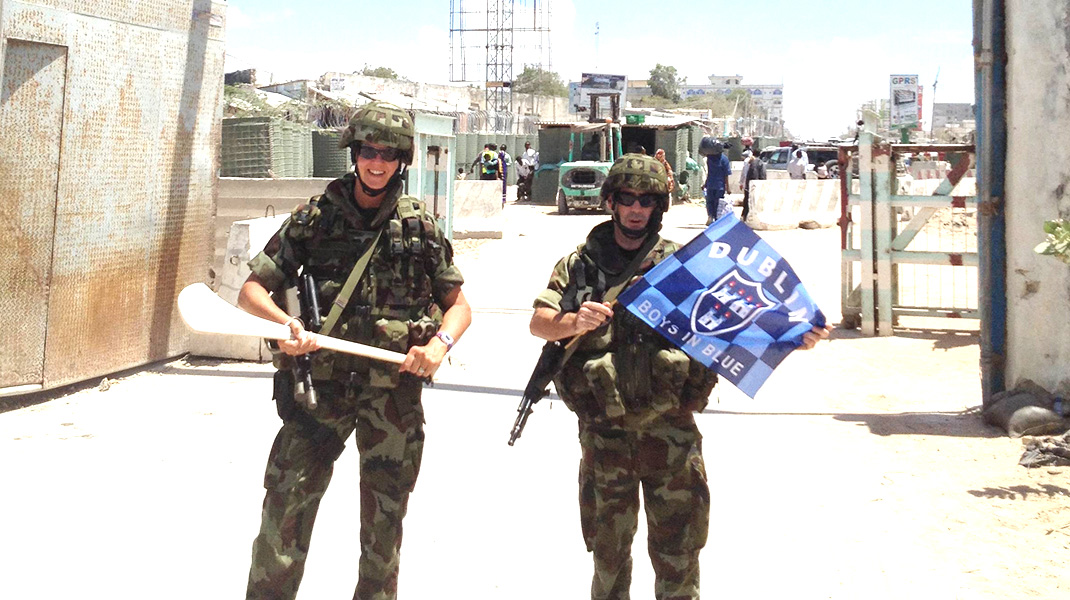
EUTM (Somalia) – April 2010 to April 2014
On 25 January 2010, the Council agreed to set up a military mission to contribute to training of Somali security forces.
The training of Somali security forces has started in the beginning of May 2010. This mission is conducted in Uganda, which also facilitate close coordination with EU partners, including the TFG of Somalia, Uganda, the African Union, the United Nations and the United States of America.
The Defence Forces have deployed ten personnel to EUTM Somalia. Three Staff Officers are posted to the Mission HQ in Kampala, one Officer and two NCOs are CIS Support, one Officer in the Mission Support Cell in Brussels, and an Officer and two NCOs are deployed to the Bihanga Training Camp, where they work as part of a team with three members of the Maltese Armed Forces.
Since the EUTM mission was launched in April 2010, part of the mission was to improve the training facilities at the Bihanga Training Camp. The new facilities include dormitories for the trainees, a firing range, a fighting in built up area training facility, a parade ground and an airstrip.
| Operation Details |
| Ribbon for the Medal |
 |
| Duration |
April 2010 to April 2014 |
| Operation type |
European Union led Training Mission |
| Commitment |
10 Personnel |
United Nations Operation in Côte d’Ivoire
UNOCI – 2004 to 2016
Acting under Chapter VII of the UN Charter, the Security Council, by its resolution 1528 (2004) PDF Document of 27 February 2004, established the United Nations Operation in Côte d’Ivoire (UNOCI) as from 4 April 2004 with a mandate to facilitate the implementation by the Ivorian parties of the peace agreement signed by them in January 2003.
Following the 2010 Presidential election and the ensuing political crisis in Côte d’Ivoire, UNOCI has remained on the ground to protect civilians, provide good offices, support the Ivorian Government in disarmament, demobilization and reintegration (DDR) of former combatants as well as on security sector reform, and monitor and promote human rights.
| Operation Details |
| Ribbon for the Medal |
 |
| Duration |
2004 to date |
| Operation type |
UN led Peacekeeping Operations (Observer) |
| Commitment |
2 |
